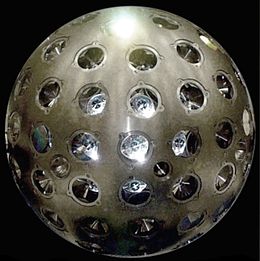LARES (Laser Relativity Satellite) is a passive satellite system of the Italian Space Agency.[4]
 LARES satellite | |
| Mission type | Laser ranging satellite Tests of general relativity[1][2] |
|---|---|
| Operator | Italian Space Agency (ASI) |
| COSPAR ID | 2012-006A |
| SATCAT no. | 38077 |
| Website | http://www.lares-mission.com/ |
| Mission duration | LARES 1: 12 years, 4 months and 1 day (elapsed) LARES 2: 1 year and 11 months (elasped) |
| Spacecraft properties | |
| Manufacturer | Carlo Gavazzi Space |
| Launch mass | 386.8 kg |
| Dimensions | 36.4 cm (diameter) |
| Start of mission | |
| Launch date | 13 February 2012, 10:00:00 UTC 14 July 2022, 13:13:43 UTC |
| Rocket | Vega VV01 Vega-C VV21 |
| Launch site | Kourou, ELA-1 |
| Contractor | Arianespace |
| Orbital parameters | |
| Reference system | Geocentric orbit[3] |
| Regime | Low Earth orbit |
| Perigee altitude | 1437 km |
| Apogee altitude | 1451 km |
| Inclination | 69.49° |
| Period | 114.75 minutes |
Mission
LARES 1
LARES 1 was launched into orbit on 13 February 2012 at 10:00:00 UTC. It was launched on the first Vega rocket from the ESA Centre Spatial Guyanais in Kourou, French Guiana.[5]
Composition
The satellite is made of THA-18N, a tungsten alloy,[6] and houses 92 cube-corner retroreflectors, which are used to track the satellite via laser from stations on Earth. LARES's body has a diameter of about 36.4 centimetres (14.3 in) and a mass of about 387 kilograms (853 lb).[1][7] LARES was inserted in a nearly circular orbit near 1,451 kilometres (902 mi) and an inclination of 69.49 degrees. The satellite is tracked by the International Laser Ranging Service stations.[8]
The LARES satellite is the densest object known orbiting the Earth.[1] The high density helps reduce disturbances from environmental factors such as solar radiation pressure.[citation needed]
Scientific goals
The main scientific target of the LARES mission is the measurement of the Lense–Thirring effect with an accuracy of about 1%, according to principal investigator Ignazio Ciufolini and the LARES scientific team,[9] but the reliability of that estimate is contested.[10]
In contrast, a recent analysis of 3.5 years of laser-ranging data reported a claimed accuracy of about 4%.[11] Critical remarks appeared later in the literature.[12][clarification needed]
Beyond the project's key mission, the LARES satellite may be used for other tests of general relativity as well as measurements in the fields of geodynamics and satellite geodesy.[13]
LARES 2
A second satellite, LARES 2, was launched into orbit on 13 July 2022 at 13:13:43 UTC on a Vega-C.[14] It was originally due to launch in mid-2021.[15][16] The launch was delayed to mid-2022 due to continuing impacts from the COVID-19 pandemic.[17][18]
LARES 2 may improve the accuracy of the frame-dragging effect measurement to 0.2%.[19] Concerns about the actual possibility of reaching this goal were raised.[20] LARES 2 is made of a nickel alloy instead of a tungsten alloy.[21]
See also
- LAGEOS similar satellites launched in 1976
- List of laser ranging satellites
- List of passive satellites
- PAGEOS
- Project Echo
- Vega flight VV01
References
External links
- LARES Mission: official Web Site of LARES Mission.
- LARES - Testing of General Relativity on ASI's page.
- LARES - Pronto al via! article with images of LARES on ASI's site (in Italian).
- LARES Satellite Information LARES page on the ILRS Web Site.